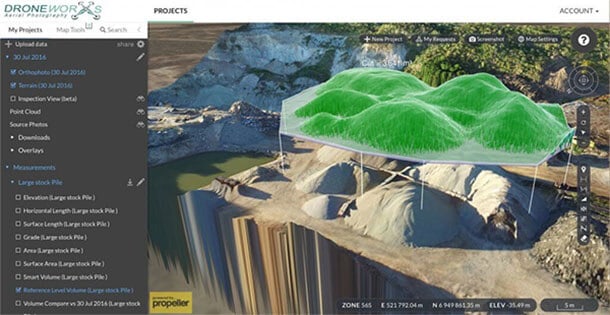How to Perform Inspections with the Help of Drones
September 11, 2017Before Starting A UAV Surveying Operation
September 11, 2017Drones are here to stay. They have changed the way we do photography, inspections and mapping. While it is true that UAV do not necessarily create a special type of map unique to only drones, they make the surveying process easier and faster. A drone will enable you to do work that would otherwise take weeks to do. The accessible of drones, also known as UAV, has created mapping hobbyists. Easily accessible, high quality, relatively low priced drones that can be gotten online such as the DJI Mavic Pro and the DJI Phantom allow amateurs to create survey-grade accurate photogrammetric maps and three-dimensional models. At Droneworxs we use a Matrice M600 drone with RTK ( Real Time Kinematic ) both on the Drone and a base station to provide mm accuracy in the XY and Z axis
Defining UAV Mapping Accuracy
There are two ways expert view accuracy in relation to drone maps, and these are global (or absolute) accuracy and local (or relative) accuracy.
Local accuracy / Relative accuracy: Relative accuracy is defined by given locations or points on the map. Relative accuracy is the degree of accuracy of points on a map to other points on the same map. For instance, if the distance from point A to point B measures 5 miles on the map, the distance should also measure 5 miles in the real world.
Global accuracy: With absolute accuracy, the coordinates of point on the map have to be concur with a fixed coordinate system (for example GPS coordinates). That way the map will be accurate in relation to other maps of different locations as far as those maps are also globally accurate. For example, the latitude and longitudes of a location on the drone map has to correspond to that of the point’s real world GPS coordinates.
Determining the Accuracy Level of a Drone Map
Since accurate drone maps appear identical to inaccurate drone maps, determining if a three-dimensional model, DEM, or orthophoto map is accurate requires surveying calculation and error study. However, when you have a clear sky, a stable flight, good GPS conditions, regular terrain, a proper image overlap, and characteristic points/ground control points (to be used in matching images taken), the map will usually be accurate. However, the only way to tell for sure is to use an error study. Measuring several points on the field being mapped in addition to the ground control points will enable you to calculate the accuracy level of the map using regular surveying calculation techniques.
Another way to determine accuracy is by measuring distances between certain characteristic points and using that to calculate the accuracy level of the map. You can measure points such as the distance between two manmade structures, or the length of a wall. For higher accuracy, you should use high accuracy measuring tools such as a laser distance sensor.
The resolution of the image also affects the accuracy of the drone’s data.
Deciding Accuracy Level of a Project
The purpose of the data will determine the allowed level of accuracy. For most application, a deviation of 30 centimeters (1 foot) is more than tolerable. However, on some projects, a maximum acceptable error level is 2 centimeters obligatory.
In accordance with the USGS Global Navigation Satellite System Committee, meeting accuracy requirement is the sole responsibility of the mapmaker/surveyor. The accuracy standards are determined by a standardization organization for aerial mapping of the respective jurisdictions.
Before we conclude, it is crucial to know that, it is okay to simply meet accuracy requirement. For instance, if the project demands accuracy levels of 30 centimeters, it is not advisable to go the extra mile and ensuring your data is accurate to 2 centimeters. Higher resolution and accuracy result in a higher volume of unprocessed raw data,which then needs to be processed and stored before presented to clients. A tiny increase in accuracy usually results in an exponential amount of raw data that needs to be processed. This takes more time, more expertise and more storage space. This can end up making unnecessarily expensive when the client does not demand that level of accuracy. For instance, a 2cm resolution survey of a 1 square km field will produce about 45 GB of raw data. A tiny increment in accuracy to a 1 cm resolution will produce more than 180 GB of raw data. This is over 4 times more raw data. Lesson? Do not over-commit to higher accuracy and resolution when not needed.

